You Create Yourself, You Destroy Yourself And You Reinvent Yourself. You Are Self-Made. http://bit.ly/36u4Ixv
Don't wanna be here? Send us removal request.
Text
“Self-control is the weakest of all things in one whose mind is not possessed by wisdom.”
— Aeschylus, Prometheus Bound (via philosophyquotes)
619 notes
·
View notes
Text
“I’m caught between trying to live my life, and trying to run from it.”
— Stephen Chbosky, The Perks of Being A Wallflower (via books-n-quotes)
32K notes
·
View notes
Photo




Sage Kotsenburg. Jossi Wells Invitational 2018 - Big Air. Cardrona Alpine Resort.
7 notes
·
View notes
Video
Who else would hit this run all day long??? Looks so fun!
🏂: @sagekotsenburg
🎥: @gimbalgod @creativespenny
.
.
.
#PeakSnowboarding #Snowboard #Snowboarding #Snowboarder #SnowBunny #Mountain #Gnar #Shred #GoProSnow #Snow #SageKotsenburg #SnakeRun #Boarding #SkiResort
1K notes
·
View notes
Text
“Have patience with all things but first of all with yourself.”
— Saint Francis de Sales
775 notes
·
View notes
Text

Happy Common Sense Day!
0 notes
Text
“If you want to know who controls you, look at who you are not allowed to criticize.”
— Voltaire
632 notes
·
View notes
Text
Can we reverse diabetes?

One great thing about practising medicine is that you get to meet people from all walks of life — from the poor to the rich, from the powerful to the common man. Everyone views their health differently: some refuse to believe they have been successfully treated, some think that just because their symptoms have disappeared, they can stop medication. The latter approach can be disastrous in the case of diabetes, high blood pressure, disturbed blood fats and an underactive thyroid, conditions that may require lifelong treatment with adjustments. Many people ask me if diabetes can be reversed. It’s a complex subject with no single answer. For starters, you have to ascertain how long the sugar level will remain normal without drugs. The number of people with diabetes globally rose from 108 million in 1980 to 422 million in 2014, according to the World Health Organization (WHO). There is some research that tells us that people with type II diabetes can achieve remission through dietary and lifestyle changes. The study ‘Surgical Treatment and Medications Potentially Eradicate Diabetes Efficiently’ (STAMPEDE) and other trials by Pories WJ et al, published in the New England Journal of Medicine and the Annals of Surgery, examined the impact of bariatric operation on sugar levels. The work suggested that type II diabetes can be sent into remission.

Studies involving low-carb diets have produced encouraging results.
This spurred the Diabetes Remission Clinical Trial, or DIRECT, which studied the condition of 298 people who had been diagnosed with type 2 diabetes in the past six years but were not taking insulin. Half of them were treated under the best medical practice guidelines, while the other half underwent an intensive weight reduction programme. They were put on a liquid diet not exceeding 850 calories for three to five months before being gradually given proper food over the next two to eight weeks. At the end of one year, 24 per cent of the respondents in the diet group had lost 15 kg or more, and 46 per cent were in remission compared to just 4per cent of the patients in the control group. DIRECT was followed by another study by Sarah Hallberg et al and it involved 349 diabetes patients. Eightyseven patients received the usual care, and the rest opted for a low-carb diet while being connected to a health coach and physician via a mobile app. After a year, the 262 patients in the diet group lost around 12 per cent of body weight, and their triglycerides level and CRP (an index of inflammation) decreased by 24 per cent and 39 per cent, respectively. The average blood glucose level, HbA1c, in the group also went down from 7.6 per cent to 6.3 per cent, while it reported 18 per cent increase in the good cholesterol (HDL). Hallberg said it was noteworthy that many respondents who were earlier reliant on insulin were able to dramatically reduce it or stop taking it. “It is something we would never previously have known was possible. I was so blown over by the results and we should now think about using this approach as a standard of care as it outperforms current treatment,” Hallberg was quoted as saying by express.co.uk. It is also worthwhile to explore intermittent fasting. I have discussed its value in my previous columns. A recent case report by Dr Suleiman Furmli tells us about intensive dietary intervention in three patients who had been taking 70 units of insulin. After fasting intermittently two to three times a week, they were able to discontinue insulin injections. Low-carb diets were recommended to them. We know that plant based diets and Mediterranean meals reduce the risk of diabetes. By the time diabetes is diagnosed in a person, he/she has already lost 50 per cent of B cells, which produce insulin. So, what happens during the prescribed regimen? In all likelihood, the existing B cells become more efficient. Earlier, it was thought that diabetes reversal was impossible except in very early stages, and the patient would have to remain on insulin for life. The evidence of recent research says otherwise. It suggests that you could get off insulin with strict diabetic control. But I wonder how long a person would have to stick to the plan? Time and further follow-up will tell. But there is hope for the diabetic as they won’t have to commit themselves to a lifetime of medication.
53 notes
·
View notes
Photo

Want more life hacks? —> http://1000lifehacks.com
328 notes
·
View notes
Photo

Lay your arm on a flat surface and push your thumb and pinky together. If you don’t see a raised band across your wrist, you are a product of evolution. If you do, you’ve got a useless extra muscle in your arm that is slowly being erased from our genetic code.
(Source)
3K notes
·
View notes
Text
“The worst part of holding the memories is not the pain. It’s the loneliness of it. Memories need to be shared.”
— Lois Lowry
1K notes
·
View notes
Text
Skin, Hair, and Nails
Skin is our largest organ. Our eyelids have the thinnest skin, the soles of our feet the thickest.
Hair and nails are modified types of skin. Hair grows everywhere on the human body except the palms of the hands, soles of the feet, and lips. Hair grows more quickly in summer than winter, and more slowly at night than during the day.

Specialised skin cells
Melanocytes produce melanin, the pigment that gives skin its colour.
Keratinocytes produce keratin, a protein that is a basic component of hair, skin, nails, and helps create an intact barrier.
Langerhans cells help protect the body against infection.
Dermis
made up of blood vessels, nerve endings, and connective tissue.
The dermis nourishes the epidermis.
Two types of fibers in the dermis — collagen and elastin — help the skin stretch
dermis also contains sebaceous glands - surround and empty into hair follicles and pores, and produce the oil sebum that lubricates the skin and hair.
Subcutaneous tissue
Made up of connective tissue, sweat glands, blood vessels, and cells that store fat.
There are two types of sweat glands:
The eccrine glands are found everywhere and help regulate body temperature, and waste products are excreted through them.
The apocrine glands develop at puberty and are concentrated in the armpits and pubic region. The sweat is thicker and doesn’t smell, but when it mixes with bacteria on the skin’s surface, it can cause body odour.
Hair
Hair growth takes place in the papilla, which contains an artery that nourishes the root of the hair. As cells multiply and produce keratin to harden the structure, they’re pushed up the follicle and through the skin’s surface as a shaft of hair. Each hair has three layers: the medulla at the center, which is soft; the cortex, which surrounds the medulla and is the main part of the hair; and the cuticle, the hard outer layer that protects the shaft.

The colour of a person’s hair is determined by the amount and distribution of melanin in the cortex of each hair (the same melanin that’s found in the epidermis).
Hair also contains a yellow-red pigment; people who have blonde or red hair have only a small amount of melanin in their hair.
Hair becomes gray when people age because pigment no longer forms.
Nails
Nails grow out of deep folds in the skin of the fingers and toes. As epidermal cells below the nail root move up to the surface of the skin, they increase in number, and those closest to the nail root become flattened and pressed tightly together. Each cell is transformed into a thin plate; these plates are piled in layers to form the nail. As with hair, nails are formed by keratinization. When the nail cells accumulate, the nail is pushed forward.
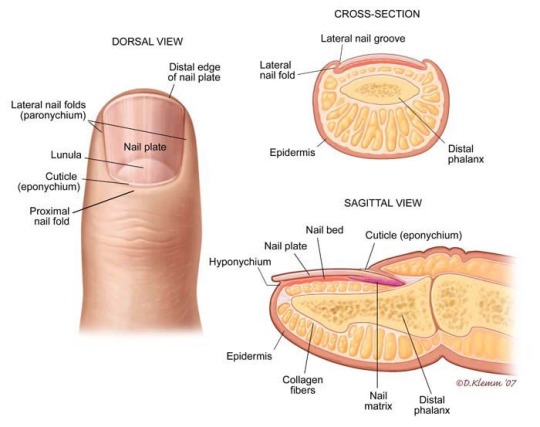
The skin below the nail is called the matrix. The nail plate looks pink because of the network of tiny blood vessels in the underlying dermis. The whitish crescent-shaped area at the base of the nail is called the lunula.
Pathologies of the Skin, Hair, and Nails
Dermatitis
The term dermatitis refers to any inflammation (swelling, itching, and redness) possibly associated with the skin. There are many types of dermatitis, including:
Atopic dermatitis (eczema). -common, hereditary dermatitis that causes an itchy rash primarily on the face, trunk, arms, and legs.
Contact dermatitis. -occurs when the skin comes into contact with an irritating substance or one that the person is allergic or sensitive to, eg poison ivy.
Seborrheic dermatitis. - oily rash, which appears on the scalp, face, chest, and back,and is related to an overproduction of sebum from the sebaceous glands.
Bacterial Skin Infections
Impetigo. - honey-colored, crusty rash, often on the face near the mouth and nose.
Cellulitis. - typically occurs when bacteria are introduced through a puncture, bite, or other break in the skin.
Fungal Infections
Ringworm. (tinea capitis)/corporis - Fungi called dermatophytes infect the skin and related tissues of the body.
Athlete’s foot. -caused by the same types of fungi that cause ringworm.
Alopecia
is an area of hair loss.
Ringworm is a common cause of temporary alopecia in children.
Can also be caused by tight braiding that pulls on the hair roots (called tension alopecia).
Alopecia areata - hair falls out in round or oval patches on the scalp.
437 notes
·
View notes
Text
Muscle tissue
Muscle tissue is made from a collection of highly specialised muscle fibres, formed by the fusion of individual muscle cells (myocytes).
All muscles are contractile and excitable and contain the proteins myosin and actin, which are responsible for contraction.
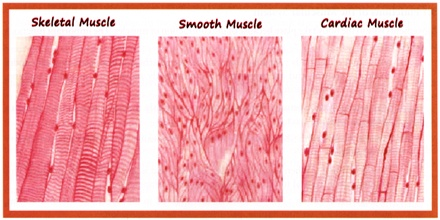
Skeletal muscles
Voluntary muscles
Attached to bones via tendons
Muscle tissue is surrounded by supporting and protecting bands of fibrous connective tissue called fascia
Plentiful nerve and blood supplies which an active muscle requires are located within fascia.
The muscle cells fuse into fibres and contain the contractile proteins actin and myosin, arranged in myofibrils, giving skeletal muscle its histological, striated appearance.
Within a myofibril, actin and myosin are interleaved, producing the characteristic striated (striped) appearance, which can be seen under the microscope and is shown schematically in the figure below. When a muscle contracts the actin and myosin slide across each other, causing the striations to bunch up.
Energy is required to relax the muscle
The default condition is contraction
When a muscle runs out of energy it contracts, as occurs in cramp and rigor mortis.
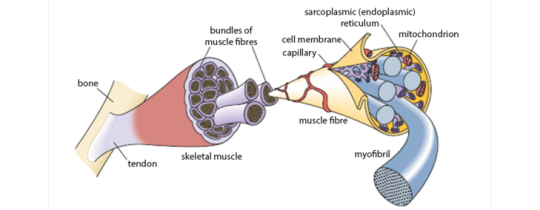
Overlapping proteins actin and myosin produce the characteristic pattern of striations in skeletal muscle.
Smooth and Cardiac Muscle
In contrast to skeletal muscle, both cardiac and smooth muscle are involuntary muscles, meaning that we cannot voluntarily control their contraction.
In cardiac muscle the myocytes form a network, with crosslinks and intercalated discs between the cells. They have striations comparable to those in skeletal muscle.
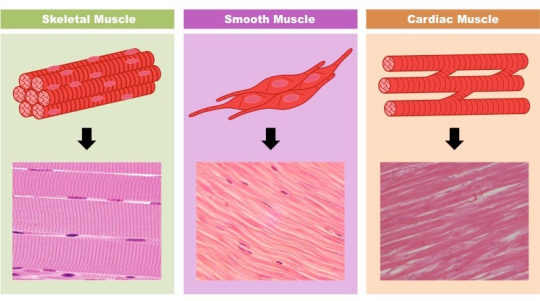
Smooth muscle is found in the wall of blood vessels and many hollow organs, including the uterus, the bladder and along all parts of the gastrointestinal tract.
Divided into two subgroups; the single-unit (unitary) and multiunit smooth muscle.
Within single-unit cells, the whole bundle or sheet contracts as a syncytium.
Smooth muscle cells are also present in the eyes and are able to change the size of the iris and alter the shape of the lens.
In the skin, smooth muscle cells cause hair to stand erect in response to cold temperature or fear.
2K notes
·
View notes
Photo



Hi lovely people!
Today I’m sharing tips how to introduce variety in body. Use the somatotypes.
It’s based on a natural occurring differences in human bodies based on differences in skeleton and body composition.
Very short tip this week but I hope you still gonna like it ! <3
4K notes
·
View notes
Photo
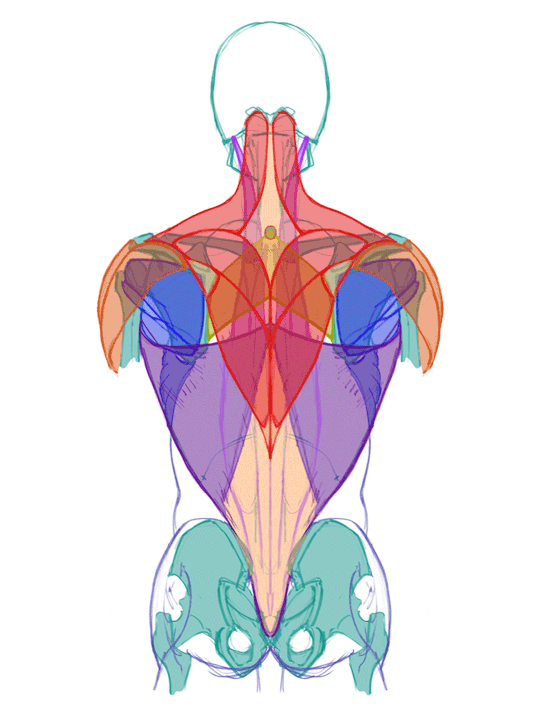

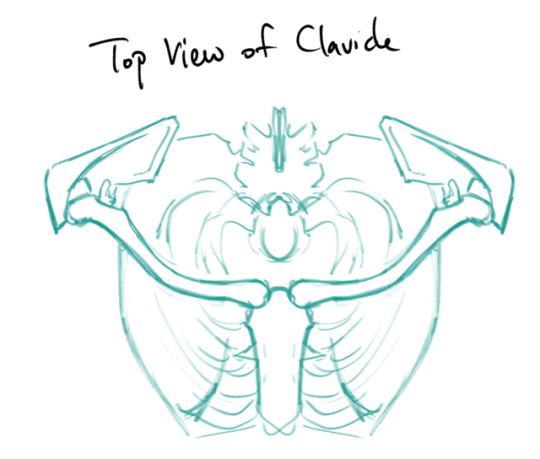
Back muscles!
SKELETAL LANDMARKS

shoulder blades: most of the upper back muscles attach to them directly, placement is affected by the arms. They can get obscured on very muscular backs, but most people these are the most dominant features!
7th cervical vertebra: neck bone that sticks out in most people, it sits in the center of that diamond shaped tendon in the middle of the trapezius
Also, obviously always keep the general shape of the ribcage and spine in mind, it was too much of a pain to draw them all in lol.
BACK MUSCLES

Erector Spinae: make the column-like structures around the spine, they extend all the way up to the neck, but you really only see the bottom part.
Latissimus Dorsi: are very thin, so most of the time you only see the structures underneath (such as the erector spinae). But when flexed, (for example, when climbing), you can see here on Jimmy Webb’s back that swooping curve it makes under the armpits.

The lats are also responsible for most of a person’s upper body strength and are the “V” shaped part of the back. For example, it’s how Bruce Lee was so strong despite being a small guy. Just look at those wings, man.

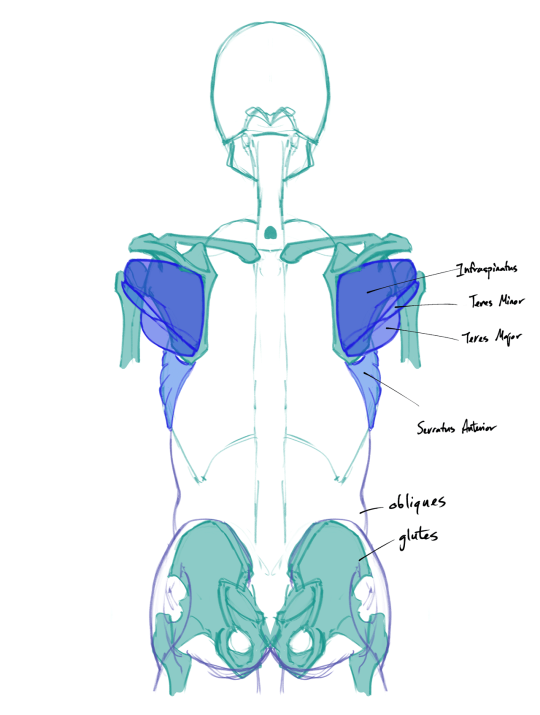
Infraspinatus, Teres Minor, and Teres Major: sit on the shoulder blade itself, and connects it to the top of the arm bone. These are responsible for a lot of the crazy shapes you see in bodybuilders’ backs.
Underneath them is the serratus anterior, which technically isn’t a back muscle but sits on the side of the ribs. These form that zig-zag pattern on the ribs that makes people look super ripped when visible with the external obliques, both wrapping around the sides of the torso. They’re not technically back muscles but fill out the silhouette, so it’s good to keep them in mind.
the glutes/butt muscles… they go farther up the back than one might assume and they, along with the pelvis, do affect the surface appearance of the lower back.

Rhomboid: simple shape, attaches from the inner edge of the shoulder blades to the middle of the spine at the 7th cervical vetebra to about the 4th or 5th thoracic vetebra. It does not overlap with the latissimus dorsi

Trapezius: divided roughly in the top, middle, and bottom sections. The top is quite thick and cylindrical and makes the sloping shape from the neck to the shoulders.
The bottom part is very thin; like the latissimus dorsi, the forms underneath it are visible when relaxed, making the rhomboid visible if it is flexed and the traps are not. Also not where the bottom part’s tendons attach to the shoulder blades; it outlines the curve of the shoulder blades even in people who are covered in brains muscles.
When fully flexed, it doesn’t taper into a point, but makes a small “w” shape at the bottom.
The 7th cervical vertebra sits at the center of the diamond-shaped tendons between the first and second sections of the trapezius. This part appears recessed in very muscular people.

Deltoid: not really a back muscle, but they overlap with the Infraspinatus and insert into the upper ridge of the shoulder blades, so it’s good to see how they interact with the others.
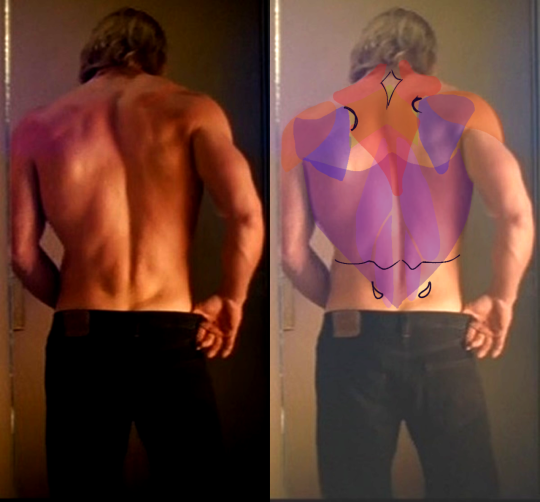
Ah, now for an example, featuring Thor himself. Note the curve where the traps meet the shoulder blades, the diamond-shaped tendon, and the rough “w” shaped contour of the lower back. Also note the two dimples, which is formed by the pelvis bones. They tend to be more prominent in women, although they are found in both men and women.
Try to find the back muscles on other people yourself, and then GET DRAWING
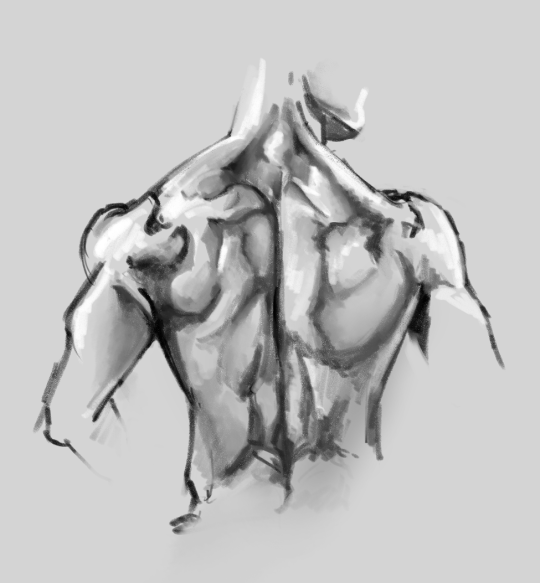
(PS, Generally it’s best to be able to simplify the forms instead of trying to render straight away - that’s how you know you really internalized the anatomy! I… honestly still don’t understand the back enough to do that yet, hence the lack of examples, unlike with the forearms post. But nonetheless, I hope that this is still useful as a general reference. I know it’s helped me at least remember what the different parts are, even if I don’t yet have a grasp of how they interact in motion!)
10K notes
·
View notes

